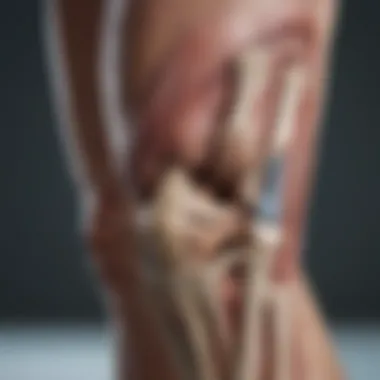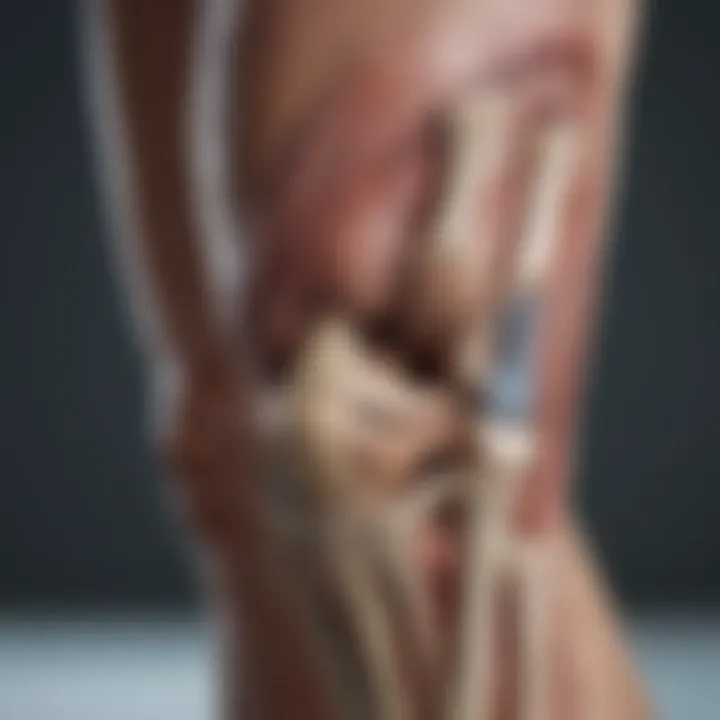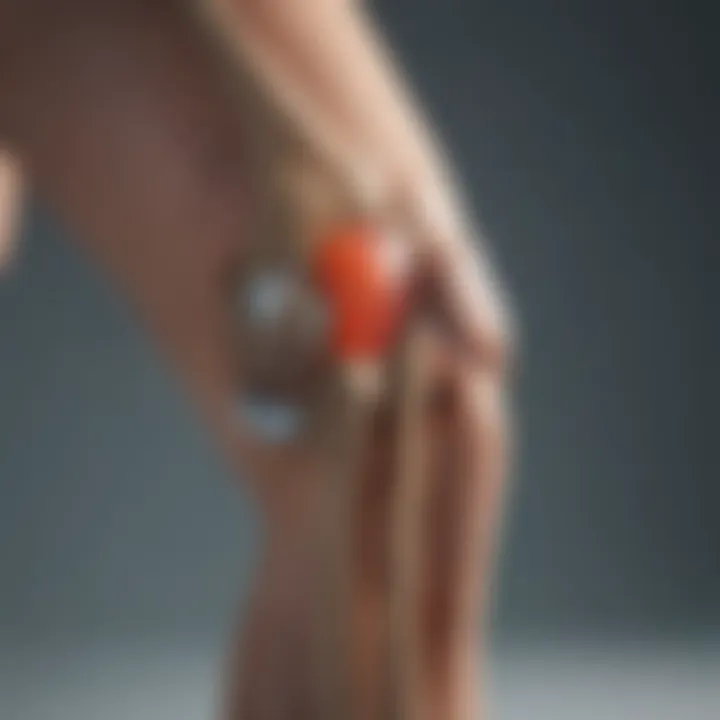Understanding Arthritic Knee and Thigh Pain


Intro
Arthritis in the knee is a common complaint that affects many people, especially as they age. However, a less frequently discussed topic is the link between knee arthritis and thigh pain. Understanding this relationship is crucial for both patients and healthcare professionals. When knee arthritis develops, it often sets off a chain of events that can lead to pain in the surrounding muscle areas, particularly the thigh. This article aims to provide insights into this connection, outlining anatomical factors, pain mechanisms, treatment options, and preventive measures.
Key Concepts
Definition of Primary Terms
- Arthritis: A term that refers to inflammation in the joints, leading to pain, stiffness, and limited mobility. Common types include osteoarthritis and rheumatoid arthritis.
- Referred Pain: A phenomenon where pain is perceived at a location other than the site of the injury or condition. Thigh pain can be an example of this in knee arthritis cases.
- Thigh Muscles: These include major muscles such as quadriceps and hamstrings, which are essential for movement and stability.
Related Concepts and Theories
Understanding the connection between knee arthritis and thigh pain involves several anatomical and physiological theories. The knee joint itself does not operate in isolation. When inflammation occurs, it can affect the surrounding muscles and even alter gait patterns.
Theories suggest that as the knee joint becomes more painful, compensatory mechanisms kick in, leading to overuse of certain thigh muscles. This can create pain due to muscle fatigue or strain. Thus, it's crucial to explore both the local effects of arthritis and the systemic reactions throughout the body.
Future Directions
Gaps Identified in Current Research
Despite increased awareness, substantial gaps remain in understanding the direct mechanisms linking knee arthritis to thigh pain. Current studies often focus on either knee issues or muscle pain, but seldom do they address the interaction comprehensively.
Suggestions for Further Studies
Research could benefit from longitudinal studies that track patients over time. Investigating muscle engagement and the effect of physical therapy on both the knee and thigh pain could provide valuable insights. Additionally, exploring the potential differences among various population groups could enhance our understanding of the complexity of this condition.
Prolusion
The topic of the relationship between arthritic knee conditions and thigh pain is significant for various reasons. Understanding this connection can enhance both diagnosis and treatment for patients experiencing discomfort related to these conditions. Knee arthritis often manifests through various symptoms that can significantly undermine mobility and quality of life. Identifying the interplay between knee joint inflammation and pain radiating to the thigh area provides insights necessary for effective management strategies.
Awareness of this connection allows healthcare providers to offer better evaluations and recommendations. Moreover, patients can gain a better perspective on their condition, leading to improved self-management. Thus, engaging with this topic not only adds to the clinical discourse but also grants practical benefits for treatment and rehabilitation.
Overview of Arthritis
Arthritis refers to inflammation of the joints, leading to pain, stiffness, and decreased range of motion. Multiple forms of arthritis affect the knee, including osteoarthritis and rheumatoid arthritis. Osteoarthritis is the most prevalent form, resulting from wear and tear on the cartilage that cushions the joint. This gradual degeneration often leads to increased friction between the bones, causing pain.
On the contrary, rheumatoid arthritis is an autoimmune disorder where the body's immune system mistakenly attacks joint tissues. This leads to significant swelling and pain, often affecting multiple joints concurrently. Understanding these distinctions is crucial, as the treatment approaches vary significantly depending on the type of arthritis.
Key Types of Arthritis Include:
- Osteoarthritis: Degenerative joint disease caused by aging and stress on joints.
- Rheumatoid Arthritis: Autoimmune condition creating systemic inflammation.
- Gout: Resulting from uric acid crystals in the joints, leading to sudden episodes of intense pain.
- Psoriatic Arthritis: Associated with skin psoriasis and involves joint pain and swelling.
The underlying mechanisms of knee arthritis underscore the importance of timely diagnosis and intervention to prevent complications that might exacerbate existing pain in the thigh.
Knee Anatomy and Functionality
Understanding the anatomy of the knee is essential in comprehending the implications of knee arthritis. The knee is a complex joint composed of bones, cartilage, ligaments, and tendons. Key components include:
- Femur: The thigh bone, which meets the kneecap.
- Tibia: The larger bone in the lower leg, it supports weight-bearing activities.
- Fibula: A smaller bone that stabilizes the ankle and supports the leg.
- Patella: Also known as the kneecap, it protects the knee joint and aids leg extension.
- Cartilage: A smooth tissue covering the ends of these bones, facilitating movement and absorbing shock.
The knee joint functions as a hinge joint, allowing for flexion and extension movements. It plays a critical role in supporting the body’s weight during various activities such as walking, running, and climbing. When knee arthritis occurs, the functionality of the joint diminishes, leading to pain and stiffness. This reduced functionality can directly impact the mechanics of the thigh muscles.
Thus, understanding the anatomy and functionality of the knee can provide insights into how arthritic changes contribute to pain in the surrounding areas, such as the thigh.
Understanding Arthritic Knee Pain
Understanding arthritic knee pain is crucial for both patients and healthcare providers as it leads to improved management strategies and better quality of life. Knee arthritis is a degenerative condition that affects the joint, often resulting in persistent pain and reduced mobility. This can significantly impede daily activities and diminish overall life satisfaction. Recognizing the nuances associated with knee pain can assist in developing targeted interventions, making everyday tasks more manageable for those affected by this condition.
Types of Knee Arthritis
Several forms of knee arthritis exist, each with unique characteristics and pathophysiological mechanisms. Recognizing these types informs treatment approaches:
- Osteoarthritis (OA): This is the most common form. It occurs due to wear and tear of cartilage, leading to pain, stiffness, and decreased joint function. OA typically develops with age or following joint injuries.
- Rheumatoid Arthritis (RA): An autoimmune disorder primarily attacking the synovial membrane, RA results in joint inflammation. This pain is often symmetrical, affecting both knees, and can lead to crippling deformities over time.
- Post-Traumatic Arthritis: This type results from injuries such as fractures or significant joint trauma. It can develop years after the initial injury, causing sudden knee pain during physical activities.
- Gouty Arthritis: This condition arises from elevated uric acid levels, leading to painful inflammation, often more acute in nature. It can affect the knee joint, causing significant discomfort.
Pathophysiology of Knee Arthritis
The pathophysiology of knee arthritis involves complex biological and mechanical processes that contribute to joint degradation. In osteoarthritis, the cartilage that cushions the joint can wear down over time. When the cartilage deteriorates, the underlying bone may become exposed, leading to painful bone-on-bone contact.


In rheumatoid arthritis, the immune system mistakenly attacks the joint tissues, leading to chronic inflammation. The synovial membrane thickens, producing excess synovial fluid. This can result in swelling and increased pressure in the joint, contributing to pain.
Key Points In Pathophysiology:
- Inflammation: Critical to both rheumatoid and inflammatory arthritis, leading to pain.
- Cartilage Degradation: A central feature of osteoarthritis, resulting in loss of joint function.
- Bone Changes: Formation of bone spurs and changes in the underlying bone structure can lead to further complications.
The culmination of these processes results in increased pain, decreased mobility, and overall difficulty performing routine activities. Understanding these mechanisms is vital in devising effective treatment strategies to manage symptoms.
The Anatomy of Pain: Thigh Area
Understanding the anatomy of pain in the thigh area is essential when examining the connection between arthritic knees and thigh discomfort. The thigh is a complex region of the body that houses vital muscles, nerves, and tissues that play significant roles in mobility and stability. A thorough comprehension of these anatomical elements helps illuminate how pain can radiate from the knee to the thigh, especially in cases of arthritis. By recognizing this connection, healthcare providers can enhance diagnosis and treatment approaches, ultimately improving patient outcomes.
Muscles of the Thigh
The thigh comprises several important muscles that contribute to its functionality and stability. These muscles can be categorized into three main groups: the anterior, posterior, and medial compartments.
- Anterior Compartment: This group includes the quadriceps, which is critical for knee extension. The quadriceps muscle group consists of four muscles: rectus femoris, vastus lateralis, vastus medialis, and vastus intermedius. It allows individuals to perform essential movements such as walking, running, and climbing stairs.
- Posterior Compartment: The hamstrings, located in this compartment, consist of the biceps femoris, semitendinosus, and semimembranosus. These muscles are responsible for knee flexion and play a crucial role in activities that involve bending the knee.
- Medial Compartment: The adductors, which include muscles like the adductor longus, adductor brevis, and pectineus, control movements that bring the legs toward the body.
Understanding these muscles is crucial, as they not only facilitate movements but also help support the knee joint. When knee pain occurs due to arthritis, these muscles may compensate for the reduced function, leading to overuse and discomfort in the thigh region.
Nervous System Role in Pain Perception
The nervous system is pivotal in the perception of pain, providing the means through which signals are transmitted from the affected areas to the brain. In the context of knee arthritis, the irritation or inflammation around the knee can trigger pain signals.
- Nerve Pathways: The sciatic nerve, for instance, branches into other nerves like the femoral nerve, which innervates the thigh area. When the knee is affected by arthritis, the pain can be perceived in regions that are innervated by these nerves. This explains why individuals with knee arthritis often report thigh pain even though the source of discomfort is in the knee.
- Central Sensitization: This phenomenon refers to how the central nervous system can become more sensitive to pain signals over time, leading to increased perception of pain in areas unrelated to the original injury or condition. In patients with chronic knee arthritis, this centralization can cause heightened sensations of pain in the thigh region.
Understanding the relationship between nerve pathways and muscle function is critical for effective pain management strategies.
In summary, the anatomy of the thigh, along with the intricacies of the nervous system's role in pain perception, contributes significantly to understanding the interplay between knee arthritis and thigh pain. Recognizing this connection aids in developing targeted therapeutic interventions and improving patient quality of life.
Linking Knee Pain to Thigh Discomfort
Understanding the link between knee pain and thigh discomfort is pivotal in addressing the multifaceted nature of joint diseases. As conditions like knee arthritis progress, they often create a cascade of symptoms affecting not only the knee but also surrounding areas, especially the thigh. Acknowledging this connection is essential for accurate diagnosis and effective treatment.
Referred Pain Mechanisms
Referred pain is a clinical phenomenon where pain experienced in one part of the body originates from a different site. It occurs due to the intricate network of nerve pathways that interconnect various regions. In the context of knee arthritic conditions, the pain originating from joint inflammation or structural changes often radiates into the thigh region.
There are several mechanisms at play:
- Shared Nerve Pathways: The sensory nerves that innervate the knee often merge with those of the thigh. Irritation or damage in the knee can thus manifest as discomfort in the thigh.
- Central Sensitization: Chronic pain conditions can alter the brain and spinal cord's response to pain stimuli, amplifying sensations and creating a scenario where even mild discomfort in the knee can trigger severe thigh pain.
- Muscle Reflexes: Any dysfunction in knee mechanics can lead to compensatory muscle actions, leading to altered muscle tension and pain perception in the adjacent thigh muscles.
Understanding these mechanisms aids in recognizing that thigh pain may not stem from direct injury or disease therein but may be an extension of knee pathology.
Muscle Compensation and Overuse
Knee pain often causes individuals to change their movement patterns. A person suffering from arthritis may guard their knee by altering how they walk or engage in daily activities. This shift leads to muscle overuse in the thighs as certain muscles are recruited more than others to maintain function and balance.
Factors to consider include:
- Altered Gait Patterns: Changes in stride length and foot placement can lead to increased strain on the quadriceps and hamstring muscles. Over time, this can result in discomfort or even injury in the thigh region.
- Imbalance of Muscle Strength: Continuous overreliance on specific muscle groups causes imbalances. If the knee is not functioning normally, certain muscles will be overworked while others may weaken, causing pain throughout the thigh muscles.
- Increased Fatigue: As the thigh muscles compensate for a compromised knee, they may become fatigued more quickly. Fatigue contributes to pain, creating a cycle that can exacerbate the discomfort.
Clinically, addressing the interplay between knee pain and thigh discomfort involves a multifaceted approach. Awareness of these factors is crucial for effective management and rehabilitation strategies, helping patients regain mobility without exacerbating pain.
Clinical Manifestations of Thigh Pain
The clinical manifestations of thigh pain are crucial to understanding how arthritic knee conditions affect overall mobility and comfort. Thigh pain often presents as a secondary symptom of knee arthritis, yet it can significantly impact the quality of life of individuals. Recognizing these manifestations helps in forming appropriate treatment plans and improving patient outcomes. This section elucidates symptoms and diagnosis, as well as differential diagnosis considerations, to enhance the understanding of thigh pain.
Symptoms and Diagnosis
Thigh pain may manifest in various ways, be it aching, sharpness, or weakness. Often, patients report the following symptoms:
- Localized pain in the thigh: This is usually felt in the area corresponding to the affected muscle groups.
- Radiating pain: Pain may stem from the knee and travel upwards, reflecting the connection between knee issues and thigh discomfort.
- Stiffness and reduced mobility: Individuals may experience tightness in the thigh muscles, making it difficult to walk or perform daily activities.
- Swelling or tenderness: Some may notice swelling and tenderness in their thigh area, signaling underlying inflammation.
Diagnosis typically starts with a comprehensive medical history and a physical examination. The healthcare provider may assess thigh mobility, strength, and responses to touch. Diagnostic imaging, such as X-rays or MRIs, might also be employed to determine if knee arthritis is contributing to thigh pain.
"Early recognition and treatment of thigh pain linked with knee arthritis can mitigate long-term damage and improve functionality."


Differential Diagnosis Considerations
When evaluating thigh pain, several differential diagnoses must be examined. This is essential to rule out other conditions that might be causing or contributing to the discomfort. Important considerations include:
- Muscle Strain: Injuries to the thigh muscles may mimic symptoms of arthritic pain, necessitating an appropriate physical examination.
- Nerve Compression: Conditions like herniated discs can cause referred pain in the thigh, complicating the clinical picture.
- Vascular Issues: Circulation problems may lead to pain in the thigh, requiring further investigation.
- Other Joint Conditions: Issues with the hip or spine can also produce symptoms that overlap with knee-related thigh pain.
A thoughtful approach to diagnosing these conditions, along with thorough clinical evaluation, aids in distinguishing between them. Understanding these differences forms a foundational aspect of effective treatment strategies for those suffering from both knee arthritis and associated thigh pain.
Diagnostic Approaches
Physical Examination Techniques
Physical examination remains a fundamental aspect in diagnosing knee arthritis and related thigh pain. A skilled clinician can evaluate joint mobility, swelling, and tenderness, providing critical insights into the underlying pathology. During the examination, several techniques are utilized:
- Inspection: Careful observation of the knee and thigh area helps identifying signs of inflammation or deformity.
- Palpation: Feeling the joint and surrounding muscles assists in determining areas of tenderness and swelling.
- Range of Motion Assessment: Evaluating how well the knee and thigh can move gives information about their functionality and any restrictions present.
- Strength Testing: Assessing the strength of the muscles surrounding the knee can indicate how arthritic conditions may be affecting muscle function.
The combination of these techniques enables healthcare providers to gain a comprehensive view of the patient's condition. Once the physical assessment is complete, findings from this initial evaluation can guide decisions regarding further testing or treatment.
Imaging Studies and Their Interpretation
Imaging studies are vital tools in the diagnostic arsenal for knee arthritis and associated thigh pain. Techniques such as X-rays, MRIs, and CT scans provide valuable information about the structural integrity of the knee joint and surrounding tissues. The interpretation of these images can reveal several key aspects:
- Joint Space Narrowing: This sign often indicates the severity of arthritis and can inform treatment decisions.
- Bone Spurs: These may develop as the body attempts to compensate for joint degeneration, contributing to pain.
- Soft Tissue Evaluation: MRI is particularly useful for assessing ligaments, cartilage, and muscles, helping to identify other possible sources of pain.
Understanding the nuances in imaging results requires a keen eye and expertise. It is essential for distinguishing between various types of arthritis and related conditions, ensuring a precise diagnosis.
Accurate diagnostic approaches form the foundation for effective treatment options, allowing healthcare professionals to manage pain and enhance the quality of life for patients with knee arthritis.
Treatment Options for Arthritic Knee and Thigh Pain
The management of pain associated with arthritic knees and its correlation to thigh discomfort plays a crucial role in improving patient outcomes. Understanding the various treatment options available is key to addressing the symptoms effectively. These options range from pharmacological interventions to non-invasive therapies, and even surgical procedures in severe cases. Each treatment carries distinct benefits and considerations, and a combination may often be the best approach.
Pharmacological Treatments
Pharmacological treatments involve the use of medications to alleviate pain and reduce inflammation in arthritic knees. Common options include:
- Nonsteroidal Anti-Inflammatory Drugs (NSAIDs): Medications like ibuprofen and naproxen are widely used to minimize pain and inflammation. They are effective but can pose risks like gastrointestinal issues with prolonged use.
- Corticosteroids: These drugs, often administered via injections, provide rapid relief by directly targeting inflammation in the knee joint. However, frequent use may lead to joint deterioration over time.
- Analgesics: Acetaminophen is a popular choice for mild to moderate pain relief, but it lacks anti-inflammatory properties. It is generally well-tolerated but may not address the root cause of knee discomfort.
- Disease-Modifying Antirheumatic Drugs (DMARDs): In cases of rheumatoid arthritis, DMARDs can help to slow the disease's progression. Regular monitoring is essential, as these drugs can have significant side effects.
Each of these treatments requires careful consideration based on individual patient needs, existing health conditions, and potential drug interactions.
Physical Therapy and Rehabilitation
Engagement in physical therapy and rehabilitation is a vital aspect of recovering mobility and alleviating pain. These programs are tailored to the specific condition and involve:
- Exercise Regimens: Custom exercises focus on strengthening muscles around the knee, enhancing flexibility, and improving overall functionality. Engaging in low-impact activities, such as swimming or cycling, can be particularly beneficial.
- Manual Therapy Techniques: Hands-on approaches like massage or mobilization can assist in reducing pain and improving joint movement.
- Education and Self-Management Strategies: Patients are instructed in body mechanics and ways to avoid overuse injuries. Comprehensive understanding fosters proactive involvement in their treatment.
The integration of physical therapy can greatly enhance outcomes by not only addressing pain but also restoring movement capabilities.
Surgical Interventions
In cases where non-surgical treatments fail to provide relief, surgical options may be necessary. Key procedures include:
- Arthroscopy: This minimally invasive procedure allows surgeons to view and treat damaged cartilage in the knee. It can provide significant pain relief for some patients.
- Osteotomy: This involves reshaping bones to relieve pressure on the arthritic knees. It is most effective in younger patients with localized joint degeneration.
- Total or Partial Knee Replacement: In severe cases where knee function is significantly impaired, knee replacement surgery may be considered. This technique involves replacing damaged joint surfaces with artificial implants, which can lead to a dramatic improvement in mobility and reduction in pain.
While surgical interventions carry inherent risks, they are often the last resort when conservative treatments have been unsuccessful. Each option requires thorough evaluation and discussion with healthcare providers to determine the most suitable course of action.
The effectiveness of these treatment options can vary based on individual health factors, making personalized treatment plans essential for managing arthritic knee and thigh pain.
Understanding treatment possibilities empowers both patients and healthcare professionals to make informed decisions and strive towards optimal pain management and improved quality of life.
Preventative Strategies
Preventative strategies hold great significance in managing thigh pain linked to arthritic knee conditions. Understanding how to prevent the exacerbation of symptoms can significantly impact a patient's quality of life. Such strategies serve not only as a means of symptom management but also as proactive measures to maintain mobility and functional independence.
The key elements of preventative strategies include lifestyle modifications, exercise, and education. By incorporating these elements into daily routines, individuals can create a robust defense against the discomfort and dysfunction caused by knee arthritis.
Lifestyle Modifications


Lifestyle modifications entail various changes individuals can make in their daily lives to reduce the strain on the knees and improve overall health. These changes often include dietary adjustments, weight management, and ergonomic considerations.
- Dietary Adjustments: A well-balanced diet rich in anti-inflammatory foods, such as fruits, vegetables, omega-3 fatty acids, and whole grains, can be beneficial. Studies suggest that inflammation contributes to joint pain, and a diet that reduces inflammation may ease symptoms.
- Weight Management: Carrying excess weight can intensify the strain on knee joints. Losing even a small percentage of body weight can significantly relieve pressure on the knees, potentially reducing associated thigh pain.
- Ergonomic Considerations: Modifying workspaces and home environments to support joint health can also aid in prevention. Utilizing chairs with proper support or adjusting the height of work surfaces can minimize stress on the knees during activity.
Exercise and Strength Training
Exercise and strength training are essential components of a preventative strategy against knee and thigh discomfort. Engaging in regular physical activity builds muscle strength, improves flexibility, and maintains joint function. Low-impact exercises like swimming or cycling provide cardiovascular benefits without excessive stress on the joints.
- Strength Training: Developing muscles around the knees through targeted strength training can provide better support to the joint. Strengthening the quadriceps and hamstrings is particularly important. These muscles help stabilize the knee and can reduce pain during movement.
- Flexibility Exercises: Incorporating stretching routines can enhance flexibility and range of motion. Yoga or Pilates offers these benefits while promoting relaxation.
- Balance Training: Activities that improve balance are also vital. They help reduce the risk of falls and injuries, which can worsen knee conditions.
In summary, implementing these preventative strategies can have profound benefits. Collectively, they foster an environment conducive to minimizing arthritic knee pain and the associated thigh discomfort. It is vital for individuals to explore these options, possibly under the guidance of a healthcare professional, to tailor the approach best suited to their unique circumstances.
"Understanding the nuances of preventative strategies empowers individuals to take charge of their health and well-being, potentially leading to improved outcomes and a better quality of life."
Implications for Quality of Life
Understanding the implications of arthritic knee and thigh pain on quality of life is crucial. These pains affect physical abilities and daily routines. People living with arthritis often experience limitations that can lead to decreased independence. Common activities, such as walking or climbing stairs, become challenging. This can make individuals feel frustrated and helpless.
Impact on Daily Activities
The effects of pain on daily activities are both physical and emotional. For instance, tasks like getting in and out of a car or lifting objects can become more difficult. Simple movements may lead to sharp pain, causing individuals to avoid certain activities.
- Mobility Limitations: Individuals might find themselves limiting their movement to avoid discomfort.
- Changes in Routine: Altering routines to accommodate pain can disrupt normal life.
- Social Withdrawal: Pain can lead to isolation due to decreased participation in social engagements.
This adjustment to daily life often results in negative feelings. Many may feel a loss of control over their lives, leading to an increase in dependence on others.
Psychological Dimensions of Chronic Pain
Chronic pain has a profound psychological impact. It can lead to conditions like anxiety and depression. The challenges of dealing with ongoing pain might cause emotional distress. A chronic condition often brings feelings of uncertainty about the future, which complicates emotional well-being.
- Cognitive Impact: Pain can affect concentration and decision-making abilities, further complicating everyday life.
- Social Connections: Relationships might suffer as friends and family may not understand the pain experienced.
- Need for Coping Strategies: Many individuals require psychological support or therapy to manage their feelings associated with chronic pain.
"Understanding the emotional component of pain can lead to better management strategies and enhanced quality of life."
Dealing with knee and thigh pain is not just about managing mobility. It involves a multidimensional approach that includes physical and mental health. Recognizing these implications can help individuals engage more effectively in their treatment and rehabilitation strategies.
Future Directions in Research
Researching the intricate link between arthritic knee conditions and thigh pain holds significant potential for future advancements in both diagnostics and treatments. Understanding this connection can lead to the development of targeted therapies that offer relief and improve quality of life for those affected. This research direction must focus on a few key elements, such as disease mechanisms, gene-environment interactions, and innovative treatment plans.
Emerging Therapies and Modalities
Emerging therapies have the potential to revolutionize how arthritic knee and associated thigh pain are addressed.
- Biologics: These medications derived from living cells target specific parts of the immune system. In inflammatory knee arthritis, biologics can reduce inflammation and improve mobility.
- Regenerative Medicine: Techniques, such as stem cell therapy and platelet-rich plasma injections, are being studied. They aim to repair damaged tissues and enhance healing.
- Wearable Technology: Devices that monitor joint activity and provide real-time feedback can help in managing movement and preventing overuse that exacerbates pain.
The continuous exploration of these and other innovative treatments is vital. Therapists and clinicians can implement emerging modalities to tailor pain management strategies.
Longitudinal Studies on Pain Progression
Longitudinal studies are critical for understanding the progression of pain in relation to arthritis. These studies track patients over time to examine how knee arthritis influences thigh pain development and changes in function.
- Understanding Pain Trajectories: Analyzing how pain evolves can help in identifying early indicators of worsening conditions. This might allow for earlier interventions, which can prevent long-term disability.
- Patient Variability: Research can uncover why certain individuals experience more severe types of pain. This might relate to factors such as genetics, lifestyle, or specific injury patterns.
- Long-term Outcomes: By assessing long-term outcomes of various treatment modalities, researchers can establish more effective management protocols and improve care strategies,
End
In the face of increasingly prevalent knee arthritis, understanding the intricate connection between this condition and accompanying thigh pain is essential. This article sheds light on the relationship these two areas share, facilitating better comprehension for both patients and healthcare professionals. Recognizing how knee arthritis can lead to thigh discomfort through various biological mechanisms is vital for effective management and treatment options.
Summary of Findings
This article outlines crucial aspects regarding the link between arthritic knee pain and thigh discomfort. Key findings include:
- Arthritis Types: Different forms of knee arthritis, such as osteoarthritis and rheumatoid arthritis, manifest distinct pain patterns that can radiate into the thigh.
- Anatomical Interactions: The interconnected anatomy of the knee and thigh, including muscles, nerves, and connective tissue, plays a significant role in referred pain.
- Compensatory Mechanisms: Patients with knee pain often alter their movement patterns, resulting in muscle compensation and overuse, which can lead to secondary thigh pain.
- Treatment Implications: An integrated approach that considers both knee and thigh pain can enhance therapeutic outcomes.
By synthesizing these findings, the article emphasizes the need for a multi-faceted approach when addressing pain in patients experiencing knee arthritis.
Recommendations for Patients and Healthcare Providers
Targeting both knee and thigh pain requires thoughtful strategies. Here are critical recommendations:
- Comprehensive Assessments: Healthcare providers should conduct thorough evaluations to understand the full scope of pain in patients. This includes assessing both the knee and thigh regions during examinations.
- Customized Treatment Plans: Tailored approaches are crucial. Patients may benefit from combined therapies that address both knee arthritis and thigh pain.
- Education on Symptom Tracking: Patients should be encouraged to maintain daily logs of their pain levels and functional status. This allows for better discussions with healthcare teams regarding treatment effectiveness.
- Preventive Strategies: Encourage lifestyle changes that promote joint health, such as controlled exercise regimes and weight management.
- Research Participation: Patients should consider engaging in clinical trials focused on the interrelationship between knee and thigh pain to contribute to future understandings and treatments.
- Physical Therapy: Focus on strengthening muscle groups around the knee and thigh can increase mobility.
- Pain Management: Utilizing pharmacological options judiciously while integrating non-drug therapies like acupuncture or massage can provide relief.
By implementing these recommendations, both patients and healthcare providers can work collaboratively to enhance quality of life and mobility in the context of arthritic conditions.



